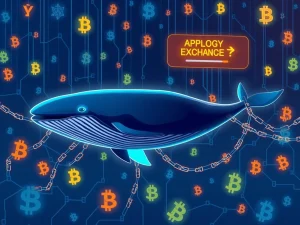Unveiling the Shocking Failure of Conor McGregor’s REAL Memecoin: Investor Lessons

The crypto world is no stranger to celebrity endorsements, but sometimes, even star power isn’t enough to guarantee success. Case in point: Conor McGregor, the notorious UFC champion, ventured into the digital currency space with his memecoin, “REAL.” Promising to be more than just hype, REAL aimed for real-world utility. But what exactly happened? And why did this highly anticipated Conor McGregor memecoin launch stumble right out of the gate? Let’s dive into the details of the REAL memecoin saga and uncover the crucial lessons for crypto investors.
What is REAL Memecoin and What Was the Big Idea?
Conor McGregor, famously known as “Notorious,” is a global icon. Beyond his UFC triumphs and entrepreneurial ventures like Proper No. Twelve whiskey, McGregor set his sights on the crypto market. In April 2025, he announced the launch of REAL memecoin, partnering with Real World Gaming (RWG) DAO. The vision? To create a staking-enabled memecoin with governance rights, differentiating it from typical hype-driven tokens.
The initial fundraising for REAL memecoin was designed as a sealed-bid auction on Axis Finance, aiming to raise a minimum of $1,008,000 in USDC. This method was chosen to prevent bot interference and ensure fair distribution. Token holders were promised staking rewards and voting rights within the REAL ecosystem, hinting at a project with substance beyond mere speculation.
The Fundraising Fiasco: Why Did REAL Memecoin Fall Short?
Despite the buzz surrounding the Conor McGregor memecoin, the fundraising round was far from a knockout. The 28-hour presale managed to collect only $392,315 USDC from 668 contributors – a mere 39% of the target. RWG DAO acknowledged the shortfall and announced full refunds to all bidders. Even McGregor himself endorsed this announcement, signaling a significant setback for the project.
So, what went wrong? Several factors converged to contribute to this celebrity crypto failure:
-
Unfavorable Market Timing: The launch coincided with a significant downturn in the crypto market. Major cryptocurrencies like Ether and Solana were experiencing sharp declines. This gloomy market sentiment made investors hesitant to invest in new, especially memecoin projects.
-
Global Economic Uncertainty: Economic instability, partly due to international trade tensions, had shaken global markets. A US stock market crash further fueled investor caution, making them less likely to take risks in volatile assets like memecoins.
-
Memecoin Scam Fatigue: The year 2024 saw over $500 million lost to memecoin rug pulls and scams. High-profile incidents, like celebrity account hacks promoting fraudulent tokens, eroded investor trust in the entire memecoin sector. This pervasive distrust undoubtedly impacted the reception of REAL memecoin.
-
Misinterpretation of Project Goals: Despite claims of utility, many investors perceived REAL as just another celebrity-endorsed memecoin lacking real substance. This skepticism undermined the project’s credibility from the outset.
-
Celebrity Token Skepticism: The crypto community has become increasingly wary of celebrity-backed tokens due to past failures. Tokens linked to even prominent figures have seen sharp declines, leaving investors burned. The failures of other celebrity tokens like Hawk Tuah and Daddy Tate have created a general sense of caution.
-
McGregor’s Controversial Image: While his “Notorious” persona is part of his brand, McGregor’s history of controversies and brash behavior didn’t translate well into the crypto space. In an environment already rife with scams, his image raised red flags for potential investors.
Tokenomics and Purpose: What Was REAL Supposed to Be?
The stated purpose of REAL memecoin was to enable staking, governance, and utility within its ecosystem, including a real-world MMA fight simulator and future business integrations. The tokenomics were presented as transparent, with:
- 32% allocated to the DAO treasury for ecosystem growth
- 17% for community distribution
- 10% reserved for the development team
However, critics pointed out flaws in the tokenomics, particularly the 12-hour unlock window. This short window allowed early investors to quickly sell their tokens for profit, potentially leading to price drops and deterring long-term investment. Furthermore, the marketing strategy was questioned, with some perceiving it as leveraging celebrity hype without offering genuine value. The use of third-party logos without clear authorization also raised red flags about the project’s credibility.
Broader Risks of Celebrity-Backed Crypto Ventures
The memecoin fundraising failure of REAL highlights the inherent risks associated with celebrity crypto endorsements. While celebrity endorsements can generate initial hype and attention, they often lack the foundation of genuine utility, long-term commitment, and technical expertise.
Celebrity crypto failure stories often follow a similar pattern: hype-driven pumps followed by devastating dumps. Early investors might profit, but those who buy in later are left holding worthless tokens. This cycle damages the credibility of the entire crypto industry and erodes public trust.
Regulatory bodies are also increasingly scrutinizing celebrity crypto endorsements, raising the specter of legal repercussions for misleading promotions. For the crypto space to mature, projects need to prioritize transparency, real-world utility, and experienced leadership over fleeting viral marketing tactics. The REAL memecoin case serves as a potent reminder that in crypto fundraising, genuine trust and long-term vision are far more valuable than celebrity clout.
Key Investor Takeaways from the REAL Memecoin Debacle
The crypto investment risks exposed by the REAL memecoin fundraising offer valuable lessons for investors:
-
Hype is Not Value: Celebrity endorsement alone is not a substitute for a solid project foundation. Don’t let hype cloud your judgment.
-
Sentiment Shifts Quickly: Initial excitement can rapidly turn into skepticism. Pay attention to community sentiment and project developments beyond the initial buzz.
-
Celebrity Power Isn’t a Guarantee: Star power doesn’t ensure project success or trustworthiness. Celebrities may lack genuine commitment or understanding of the crypto space.
-
Do Your Own Research (DYOR) is Crucial: Always conduct thorough research. Examine the project’s fundamentals, tokenomics, team, and community engagement before investing.
-
Regulatory Clarity is Needed: The lack of clear regulations around celebrity endorsements poses risks to retail investors. Increased regulatory scrutiny is essential to protect investors from misleading promotions.
Conclusion: Learning from the REAL Experience
The story of Conor McGregor’s REAL memecoin is a cautionary tale in the volatile world of cryptocurrency. It underscores that even celebrity backing cannot overcome fundamental flaws in project design, unfavorable market conditions, and a skeptical investor base. For investors, it’s a crucial reminder to look beyond the hype, conduct thorough due diligence, and prioritize projects with genuine utility and strong fundamentals over celebrity-driven ventures. The failure of REAL serves as a valuable, albeit expensive, lesson for the crypto industry and its participants, emphasizing the need for substance over celebrity fanfare in the quest for sustainable success.









